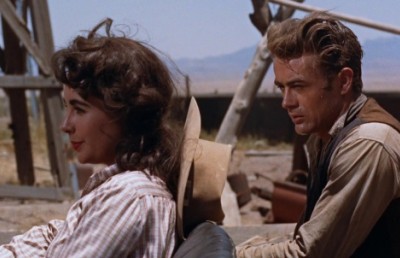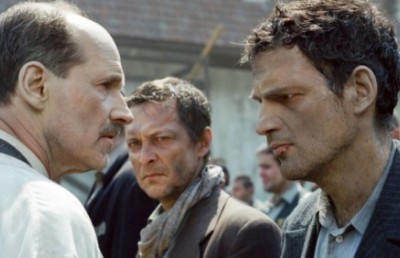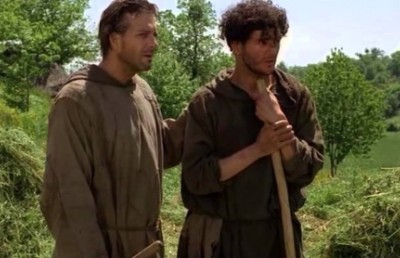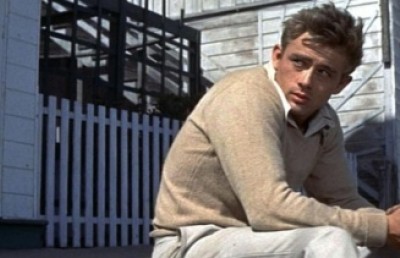Sam Peckinpah: Piece by Piece
Review of New Book on Sam Peckinpah
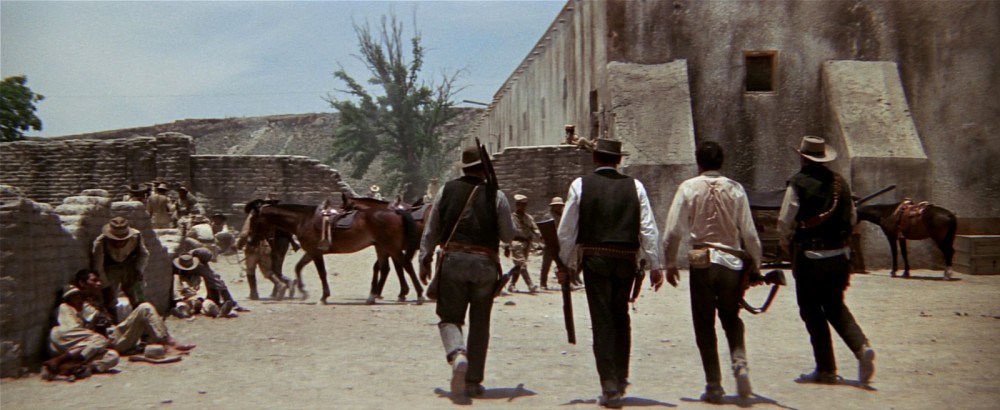
Sam Peckinpah
Publisher: capricci-2015
Edited by Fernando Ganzo
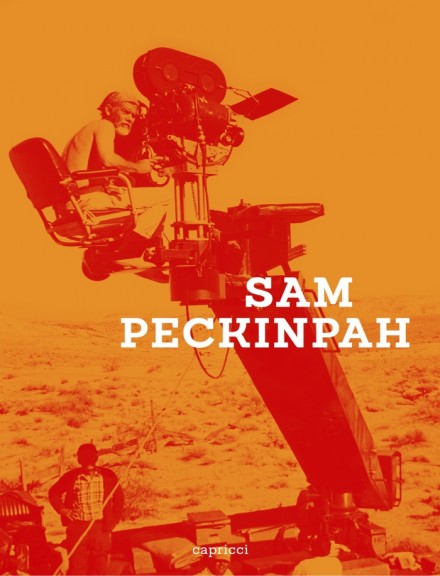
Released to tie in with the Sam Peckinpah retrospective at the Locarno Film Festival which ran 5th to 15th of August in 2015.
This book collates a number of essays as well as interviews with a few of Sam Peckinpah’s associates and/or friends. It is organized in a chronological fashion with various interpretive essays which cover a series of films broken up by “Film shoot stories” anecdotes which relate to the production time frame covered in the previous essay and/or related interview; it ends with a chapter on his television work in which Peckinpah started his career and also the occasional show while in the middle of his film production schedule.
The book begins with an editorial introduction entitled “The traitor and the hero”; the inevitable problem of writing a comparative piece on a filmmaker is the risk of dismissing filmmakers who may be just as important as your main subject. Ganzo is guilty of this when he mentions Sergio Leone in the following sentence: “We must think of the commercial success of Sergio Leone’s westerns, made at the same time, which succeeded because of his few, well-chosen fight scenes, his cartoon-like characters, and his lengthy long shots. Luckily for him, Peckinpah had something else to say….” (p.6) One cannot so easily dismiss Leone who, like Peckinpah, did great revisionist work in the same field –albeit very different to Peckinpah’s– in one sentence when broaching the subject of a western in a comparative study; but the brevity of the book leads Ganzo to make a point which can only distract from his appreciative understanding of Peckinpah. The tone of this introduction nevertheless sets a good tone for the articles to come, and one cannot fault Ganzo for being reverent of his subject; being a Peckinpah devotee myself, I found his insights refreshing and would have liked a longer overview of the filmmaker. Ganzo places Peckinpah in an historical context that relates him to America, its politics and societal issues of the time. This informs the types of characters Peckinpah would choose to populate his various canvases, and the different genres that he delved in (although Peckinpah only did a few westerns, one cannot help but find the Western philosophy spread over all his films in one way or another). The autobiographical moments in Peckinpah’s work inhabit several of his characters (not always found in the lead character, but sometimes glimpsed briefly in secondary or tertiary characters). Acknowledging that Peckinpah’ s actual filmography is not very extensive, Ganzo wraps up his intro with the inevitable story of what many writers/critics agree ruined Peckinpah’s career: the unrelenting substance abuse and drinking which ultimately claimed his life.
In Conversation with Sam Peckinpah (Movietone News, #60-61, February 1979) forms the substance of the first chapter proper. It is an edited transcript of a Q & A following a screening of his film, The Ballad of Cable Hogue, at the Seattle Concert Theatre. I can understand why this particular talk is included as it does a good job of touching on most of Peckinpah’ s career and life ambitions, and the filmmaker is refreshingly candid in such a situation. He gives his unmediated opinions of the film factory known to mere mortals as Hollywood; it makes for a great read indeed.
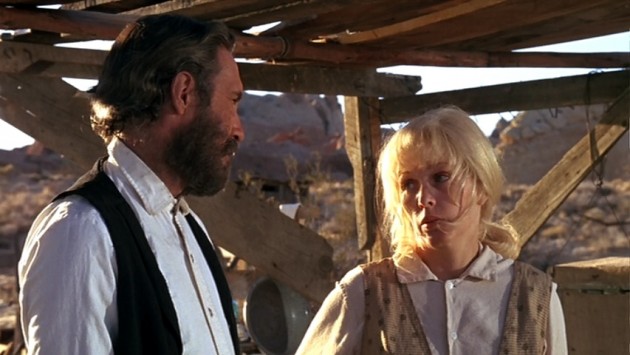
Jason Robards and Stella Stevens in The Battle of Cable Hogue
The second chapter entitled, 1961-1965, Early Lateness: Sam Peckinpah before The Wild Bunch is written by Chris Fujiwara (who is a film critic and lecturer who has taught film aesthetics and film history at Tokyo University). This chapter covers the first three features directed by Peckinpah; The Deadly Companions (1961), Ride the High Country (1962) and Major Dundee (1965). Fujiwara places Peckinpah in late period cinema and cites an example from Howard Hawks’ El Dorado whereby character flaws begin to appear in the Hero which defines the morally corrupt surroundings the characters will now inhabit in the Western. Hawks comes to this development late in his career as a filmmaker whereby Peckinpah adopts it right out of the gate (although always keeping a door open for an eventual and hopeful redemption of that character against all odds ). Times are changing in the fabric of America —a motorcar is glimpsed in Ride the High Country for the first time— and filmmakers of the sixties will uncompromisingly peel back the skin and reveal the flesh behind (Arthur Penn with Bonnie and Clyde, 1967) is a prime example, but beyond the scope of this article. The subject of violence and the way Peckinpah begins to portray it throughout his films is touched upon in this essay: the idea that Peckinpah’s violence is not only an external manifestation, but internal one as well, with mere physical evidence of its existence on the characters inhabiting his landscapes. “Peckinpah’s is explicitly a cinema of the body and its reality, the body as a record of its own past….”p.35). One could argue that the two characters played respectively by Joel McCrea and Randolph Scott (two former western stars with a long history of the genre wrapped around them, a point certainly not lost on Peckinpah), who are at either end of the good and bad equation actually merge as one for the final shootout, and the part that dies leaves the “uncertain” part of this new character alive to contemplate a changing future (in a conventional story the strong “good” hero would live on). Perhaps that idea demonstrates Peckinpah’ s own uncertainty ahead in his own films to come which will be explicitly explored in what many regard to be his most accomplished work, Bring me the Head of Alfredo Garcia, (1974). The Film Shoot Stories covering this period follows this essay.
The next chapter is an interview by Maroussia Dubreuil (contributor to the magazine Sofilm amongst other things) with one of Peckinpah’ s close associates during the 1965-74 period, Gordon T. Dawson. The interview touches the usual subjects that would be covered in a collection such as this, namely what is was like working with Peckinpah —covering production anecdotes which would be well known by any Peckinpah aficionado.
The following chapter, 1969-1973, SPURS: The styles of Sam Peckinpah, deals with my (and no doubt many others) favourite period of his work; it covers The Wild Bunch (1969), The Ballad of Cable Hogue (1970), Straw Dogs (1971), Junior Bonner (1972), The Getaway (1972) and Pat Garrett & Billy the Kid (1973). This piece is written by Emmanuel Burdeau (film critic and writer for various publications and literary director of Capricci, this book’s publisher). The writer delves into Peckinpah’s editing style and uses the opening of The Getaway to describe the editing in descriptive detail; whether the conclusions arrived at by Burdeau are definitive is arguable, and I’m sure many familiar with Peckinpah’s work will find them so. It’s too bad that this period is not the highlight of the book as I would have hoped it to be (perhaps it is due to poor translation from the French by Colette de Castro; just a guess since I am French speaking myself.) There is a very detailed analysis of that opening sequence from The Getaway mentioned above which, to me, would have best been served to study Straw Dogs’ editorial style which seems to me to be one of Peckinpah’s strongest films in terms of editing and eliciting meaning from the use of the cut and unusual use of sound that does not necessarily follow through on an edit point. (Sound from one scene will carry over a very fast cutaway back to the previous shot.) The following idea that Burdeau talks about, I believe, is better exemplified in the earlier film: “Strange connections which flip the inside and the outside, the before and the after, the loss of liberty and its reclamation” (p.79). It’s a brilliant way of seeing Peckinpah’s style of editing, and how I would love to read a more enhanced version of this piece where she could apply his theories to Straw Dogs. Burdeau draws attention to how animal cruelty finds an equal measure with human suffering in future events in the films; take this example from The Wild Bunch: “The Link between one massacre and the other is indisputable: the scene of the children setting the insects alight dissolves into the victims that Pike Thornton’s men and the railway company are going to strip like scavengers” (p.79). There is a much more satisfactory example of this idea in Straw Dogs, when Amy (Susan George) is raped while her husband David (Dustin Hoffman) is out on the moors hunting with the men who have taken him out for the purpose of leaving his home unprotected so that his wife is alone and open to danger. Peckinpah intercuts the two scenes several times up to a point where David manages to shoot a pigeon, runs to it to then picks it up, looking at its lifeless carcass with the realization of what he has just done; taking a life, albeit an animal, which Peckinpah uses to contrast with human suffering as Burdeau outlines here, which will be taken a few steps further by the end of the film. Burdeau does acknowledge though that Straw Dogs “is the film that most keenly addresses the formal but also moral relationship between linking and explosion, between discourse and destruction, between the discourse of destruction and the destruction of discourse” (p.87). His whole chapter could have been about the editorial intricacies of Peckinpah’s “most powerful film” (p.90). The chapter makes for a great (ultimately frustrating for me) read. The following Film Shoot Stories covers a few aspects of the previous film’s creations.
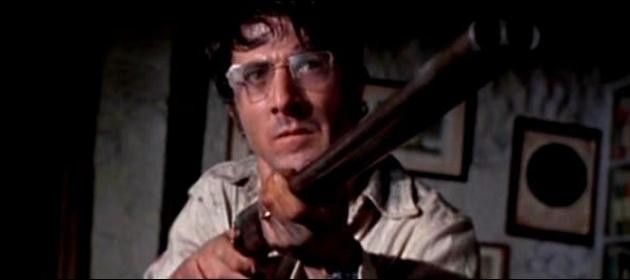
Dustin Hoffman in Straw Dogs
The following chapter, The Dance of Pat Garrett, is by Carlo Chatrian, writer, journalist and film programmer and since 2013, director of the Locarno film festival. In two pages, Chatrian examines one particular shot in Pat Garrett; it involves Garrett (James Coburn; a long time Peckinpah actor and associate) inflicting a kick to the face of a character; and how the body of Coburn interacts with that space; “a record of a physical act…..it reveals the centrality of the set as the space where Peckinpah’s cinema is created.” Chatrian makes an excellent observation that Peckinpah’s ‘“ersatz” way of making cinema has disappeared forever, but for which we remain nostalgic” (p.117).
Next is a reprint (from Movietone News) of an appreciation of The Ballad of Cable Hogue by a spiritual cousin to Peckinpah, Sam Fuller.
Then we come to what I consider to be the best chapter in the book, 1974-1983, WHEN LEGENDS DIE by Christoph Huber (Curator in the Program Dept. of the Austrian Film Museum.) It covers Bring me the Head of Alfredo Garcia (1974), The Killer Elite (1975), Cross of Iron (1977), Convoy (1978) and The Osterman Weekend (1983). One should tread carefully when opening a chapter with the following Peckinpah quote: “A drunk man dreams, a sober man doesn’t” (p.124). This quote poses the question: will the drunk man remember the dream to be able to communicate it or be inspired by it? This chapter deals with the late work of Sam Peckinpah and the increased drinking and cocaine habit which would ultimately be his undoing and would lead him to an early grave.
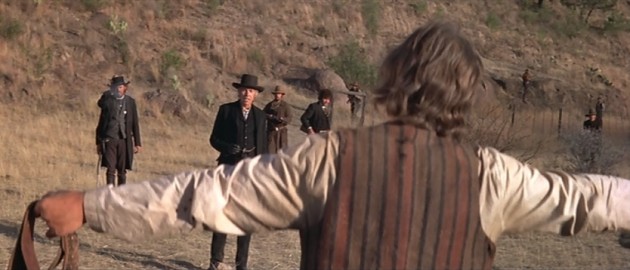
Pat Garrett and Billy the Kid
Huber has a very interesting and astute study of Bring Me the Head of Alfredo Garcia acknowledging it as a “pure” Peckinpah, unfettered by studio executive meddling: “I did this work exactly the way I wanted to. Good or bad, like it or not, that was my film” (p.124). The critical reception of this particular feature at the time of its release was not kind to Peckinpah, hindsight of course would change opinions for the better with critical re-appraisals declaring it to be one of his best films (if not his masterpiece). Huber makes a very good argument in favor of it being “a direct expression of the personal demons plaguing Peckinpah, including his constant conflicts with producers and studios” (p.125). One of Peckinpah’ s signature stylistic touches —as it would often be described by critics then and even now to some extent— displays or explosions of extreme violence, was not in evidence in Bring Me the Head of Alfredo Garcia; rather the film unfolds in a slow build up to its climax. Huber describes it as “the ultimate point of investigation for several of his (Peckinpah) major concerns, from vengeance to male-female relationships to the nature of an increasingly corrupted world and, most pronouncedly, the nature of human barbarism itself” (p.125). From that point onwards Peckinpah’s trajectory is in a downward spiral. Contemporary critics started to lose interest in his films, despite the fact that they were some of his most complex and scathing works. Huber makes a valid point here: “However flawed Peckinpah’ s four final films may be….none can be dismissed out of hand (as often happened upon their release); they show his signature style and spirit, although slackening to various degrees, as with Peckinpah’ s health” (p.127). Huber moves on to describe Peckinpah’ s growing self-destruction which ends with his last production, The Osterman Weekend: “Although all the flaws in the late films are usually and summarily attributed to Peckinpah’ s decline due to alcohol and drugs, they also serve (in a supreme irony worthy of the great ironist, Peckinpah) to “unify” this unruly body of late work, whose increasingly sinister view of modern society seems to demand an increasingly fragmented approach as the renegade’s last stand”(p. 129-130).
The following Film Shoot Stories (as the previous ones in the book) cover a few anecdotes from the production part of the films.
The book continues with an interview between Ganzo and Kris Kristofferson (one of Peckinpah’s closest friends since the Pat Garrett days), and ends with a quick study of earlier television works and how they relate back (in the book) to the films. Is there a foreshadowing of his later films or are they stand-alone works?
For a catalogue of articles printed to accompany a retrospective of Sam Peckinpah’ s work, this book finds several new avenues in which to continue their study, but by no means should it end here; each of Peckinpah’ s films deserve closer study in the end. I can’t think of any other American filmmaker who left a legacy so marked by his times as Sam Peckinpah; after reading the book (and especially Christoph Huber’s chapter), see the films with a more open critical eye and challenge yourselves with this poet’s heartfelt and desperate work.



